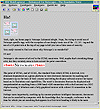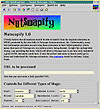 copyright notice
copyright notice  link to the published version in IEEE Computer, September, 1995
link to the published version in IEEE Computer, September, 1995




 accesses since April 8, 1996
accesses since April 8, 1996 The second protocol, HyperText Markup Language (HTML) [2], defines the internal structure of the Web's "documents". It accomplishes this through a primitive tagging convention which identifies contained or referenced resources. For example, a sensitive (clickable) document anchor which points to a uniform resource locator (URL) would be couched within the tag pairs "<A HREF=....>" and "</A> an image would be identified by the tag <IMG SRC="....">, and so forth. While unsophisticated, it works - at least for the most part.
The difficulty lies in the inconsistency with which Web client developers comply with the emerging standards. This inconsistency translates into headaches for the end user. The HTML protocol has evolved in stages, or levels, over the past three years, and it is in this evolution that the discomfort is to be found. The compliance levels are specified by the World Wide Web Consortium [3], but developers do not follow the prescription with a consistent degree of fervor.
HTML level 0 provided specifications for basic HTML structure. Included in level 0 were support for hypertext links, meager format control and limited text enhancements. Level 1 defined extensions for basic image handling, limited text enhancement and relative resource addressing . Level 2 included specifications for forms along with incremental gains in the other areas defined for levels 0 and 1. Level 3 will provide extensions for tables, a LaTeX-like, ASCII-notation standard for mathematical formulas, and features for additional multimedia support. That comes to four compliance levels in just under three years.
To make things worse, Web client conformance is usually discussed in the context of HTML versions. The HTML version 1 convention includes levels 0 and 1 standards. HTML versions 2 and 3 include levels 0-2 and 0-3, respectively. However, the HTML version numbers are really only discussed in the abstract, for the typical Web client makes no claims of compatibility - they typically add as many features as they feel they can manage before a new release, and let it go at that. Even if the user understood what was involved in these compliance issues, there would be no way to relate it to a particular product. But it doesn't end there.
There are also non-standard extensions which are emerging in parallel with the orthodox versions. This, together with the sometimes conflicting interests of the commercial vs. not-for- profit developers, is the battlefield of a technology skirmish (cf. [4]). In general, the non-standard extensions apply to the body of HTML documents and are associated with a particular Web client, Netscape. Extensions dealing with image alignment and re-sizing, box graphics and greater control over typesize and font are commonly used "Netscape" extensions.
We will ignore for the moment the problems of the feature- imbalance for the same product across multiple platforms, and implementation bugs, as they relate to the lack of client navigator/browser uniformity.
 Figure 1. Anti-Netscape
crusade. This particular navigator/browser, Web Explorer, does not support many
of the Netscape extensions. If it did, this page would be virtually unreadable
- which is the author's intention. The effect is most pronounced when viewing
this page with side-by-side navigator/browsers.
Figure 1. Anti-Netscape
crusade. This particular navigator/browser, Web Explorer, does not support many
of the Netscape extensions. If it did, this page would be virtually unreadable
- which is the author's intention. The effect is most pronounced when viewing
this page with side-by-side navigator/browsers.This conflict over standards has even become politicized over the net. At this writing there are actually "digital campaigns" for and against Netscape extensions (see Figures 1 and 2). While little of any enduring value will likely follow from this activity, that fact that it takes place suggests that there are some important issues which underlie it.
 Figure 2. An imaginative attempt to highlight the
potential of Netscape extensions. Be forewarned that non-
Netscape clients may behave strangely.
Figure 2. An imaginative attempt to highlight the
potential of Netscape extensions. Be forewarned that non-
Netscape clients may behave strangely.
 Figure 3.
Figure 3.
Figures 3 and 4 illustrate how the Web Test Pattern may be used. Observe that there is a tiled background to the homepage which is rendered correctly by Netscape version 1.2.b2 (Figure 3) but not rendered at all by NCSA Mosaic version 2.0.0b4 (Figure 4). Tiled background is an element of the proposed HTML 3 specifications.
 Figure 4.
Figure 4.
Some of the tests, as those above, are passive. The user merely loads the test document and views the result. In other cases, the tests require direct user involvement. Audio files provide a case in point for audio files are never in-line, even though their players may be integrated into the client. Most modern clients include user-configurable launch pads, so over time the importance of the distinction between integrated and spawnable perusers will vanish.
 Figure 5.
Figure 5.
As it develops, the Web Test Pattern will attempt to include as rich a variety of media as is to be found on the Web, thereby enabling both users and developers to test for compliance with HTML levels.
REFERENCES:
[1] NSFNET Backbone Traffic Distribution Statistics, April, 19995. http://www.cc.gatech.edu/gvu/stats/NSF/merit.html.
[2] World Wide Web Consortium: HyperText Markup Language, http://www.w3.org/hypertext/WWW/MarkUp/MarkUp.html.
[3] World Wide Web Consortium. http://w3.org/.
[4] Berghel, H., "OS/2, UNIX, Windows, and the Mosaic Wars," OS/2 Magazine, May, 1995, pp. 26-35.